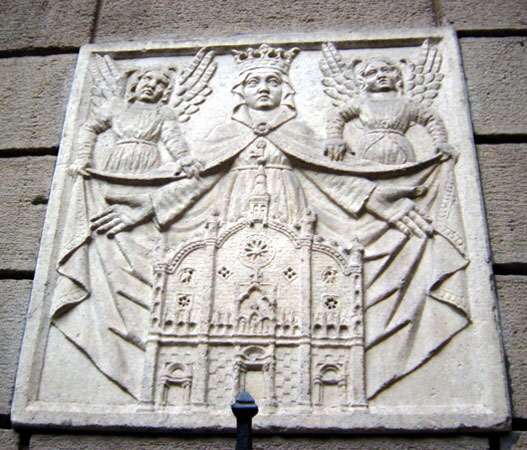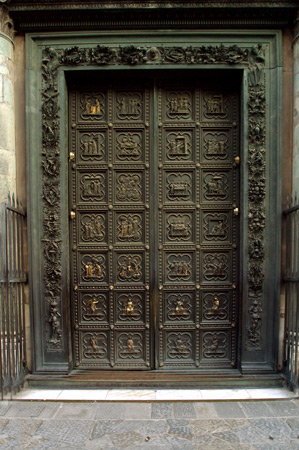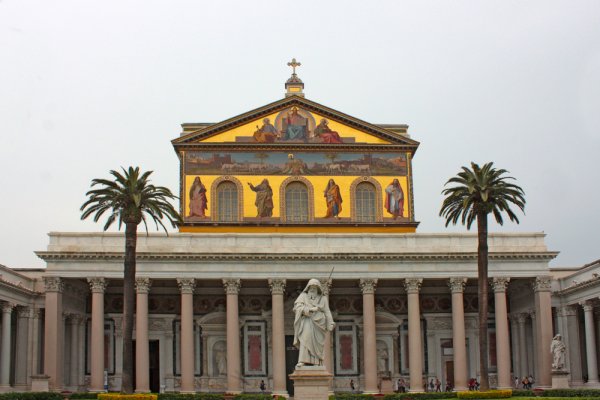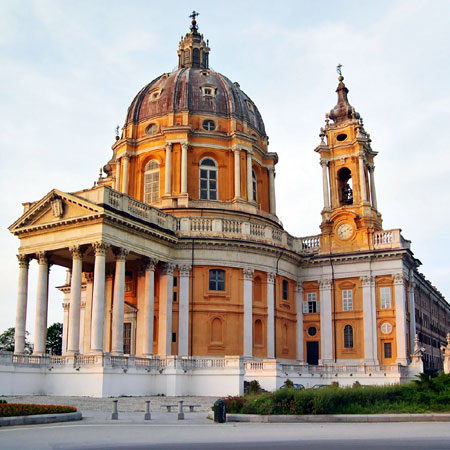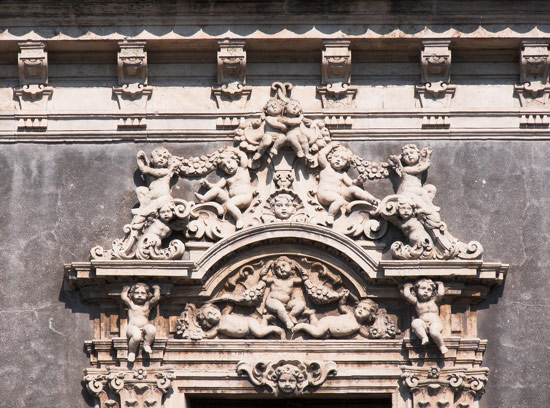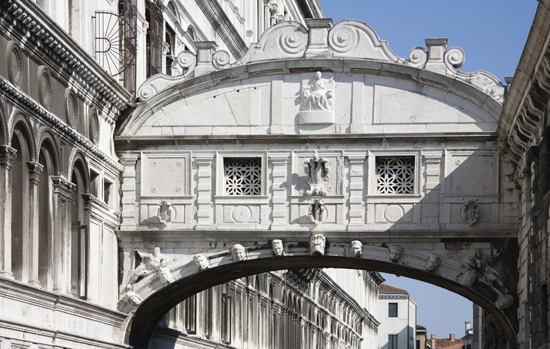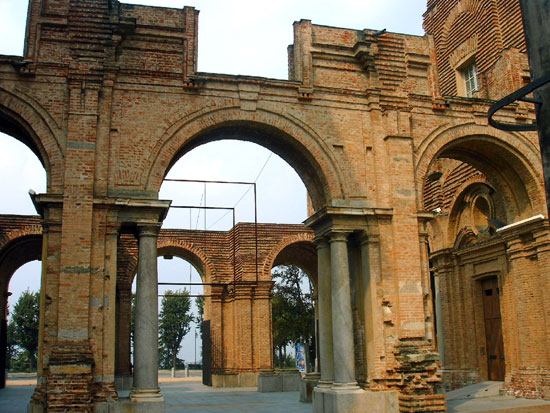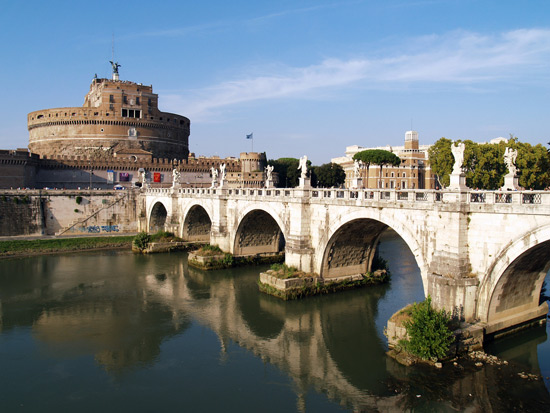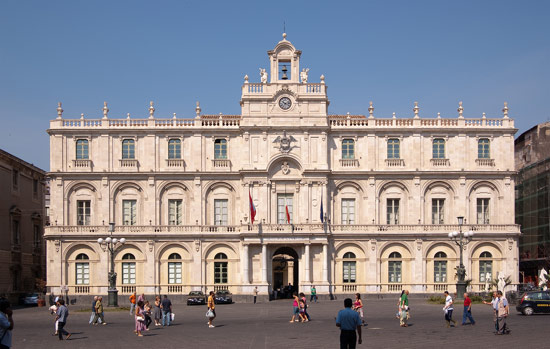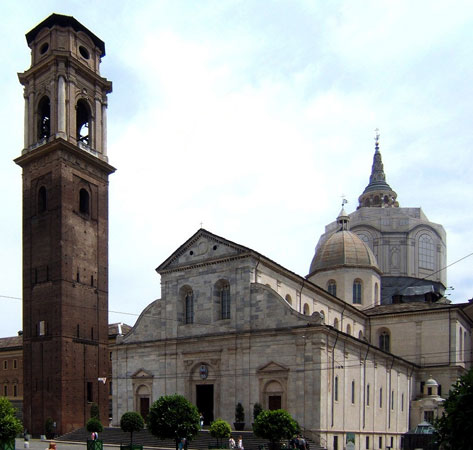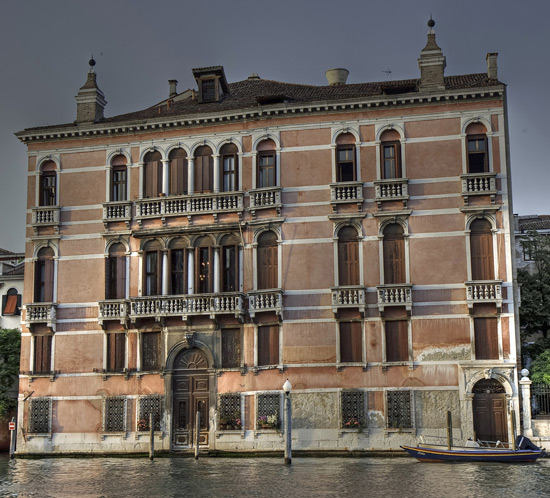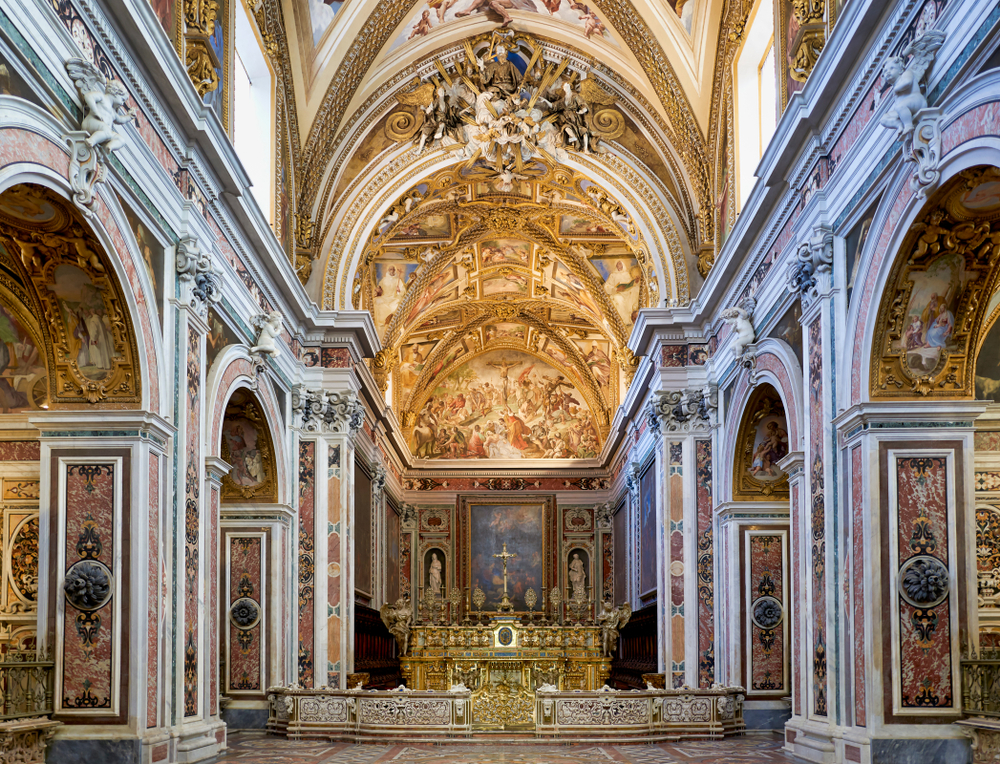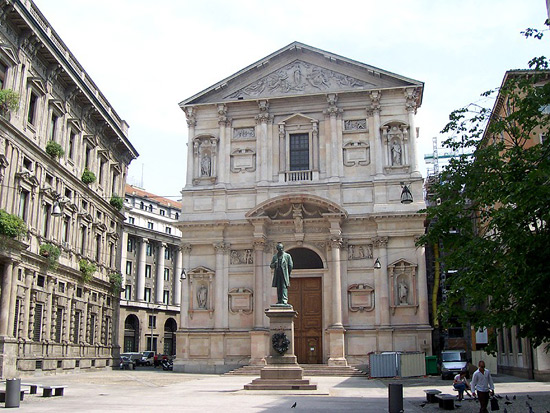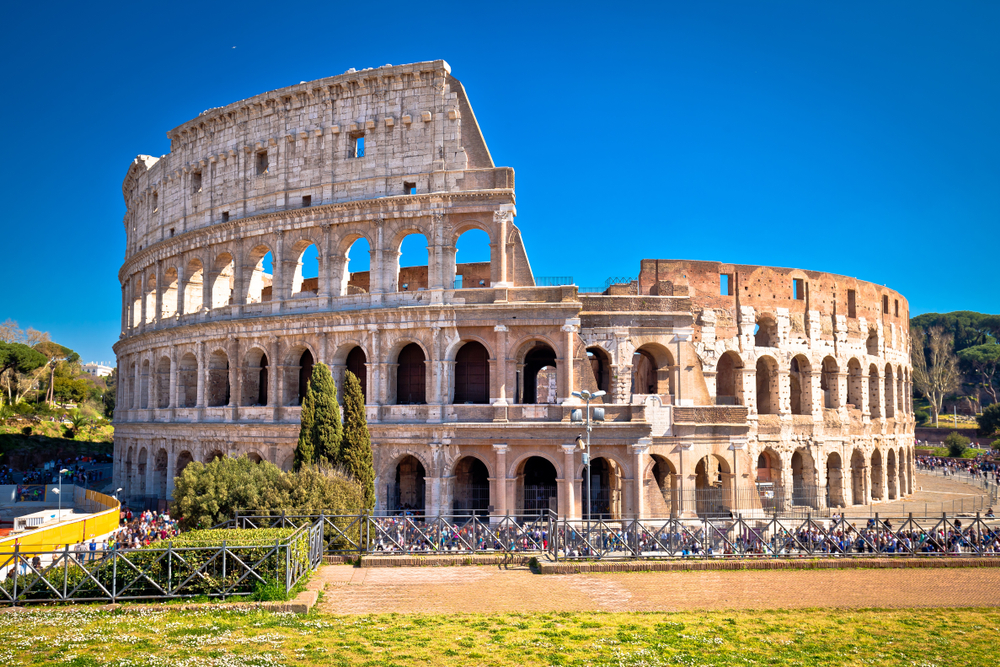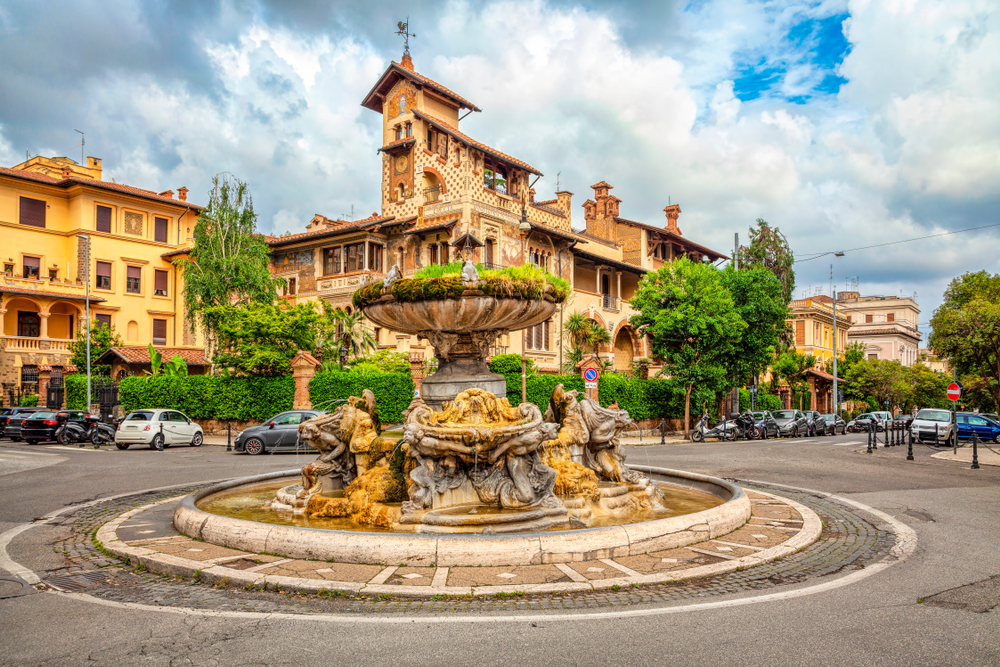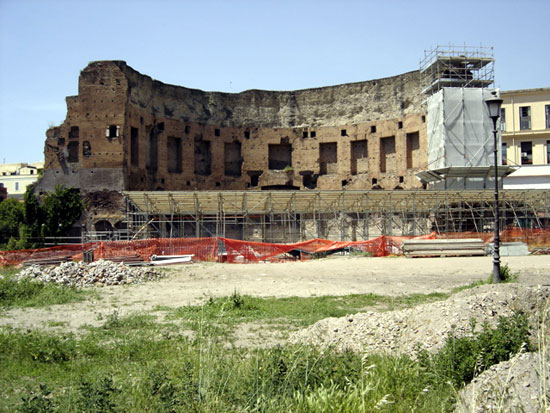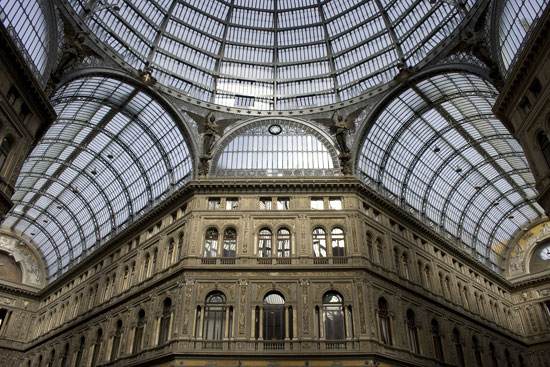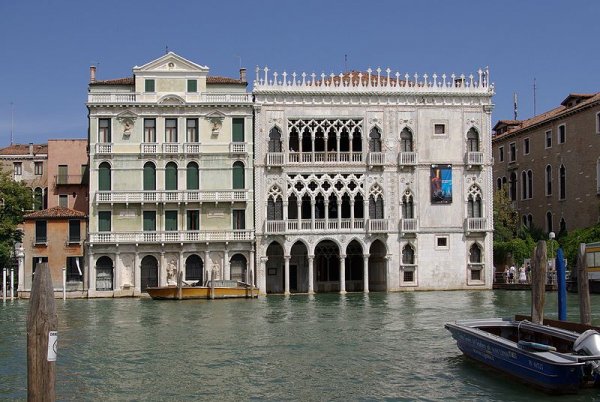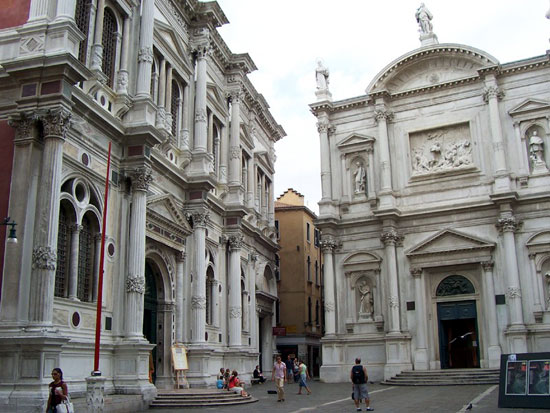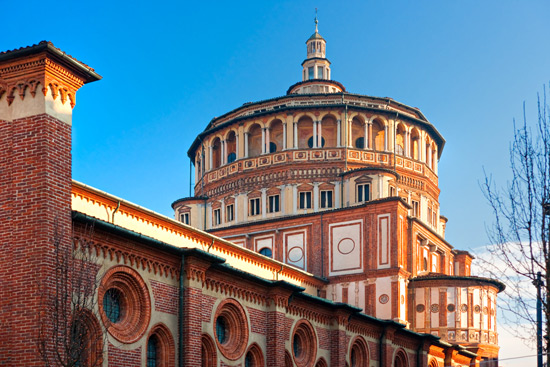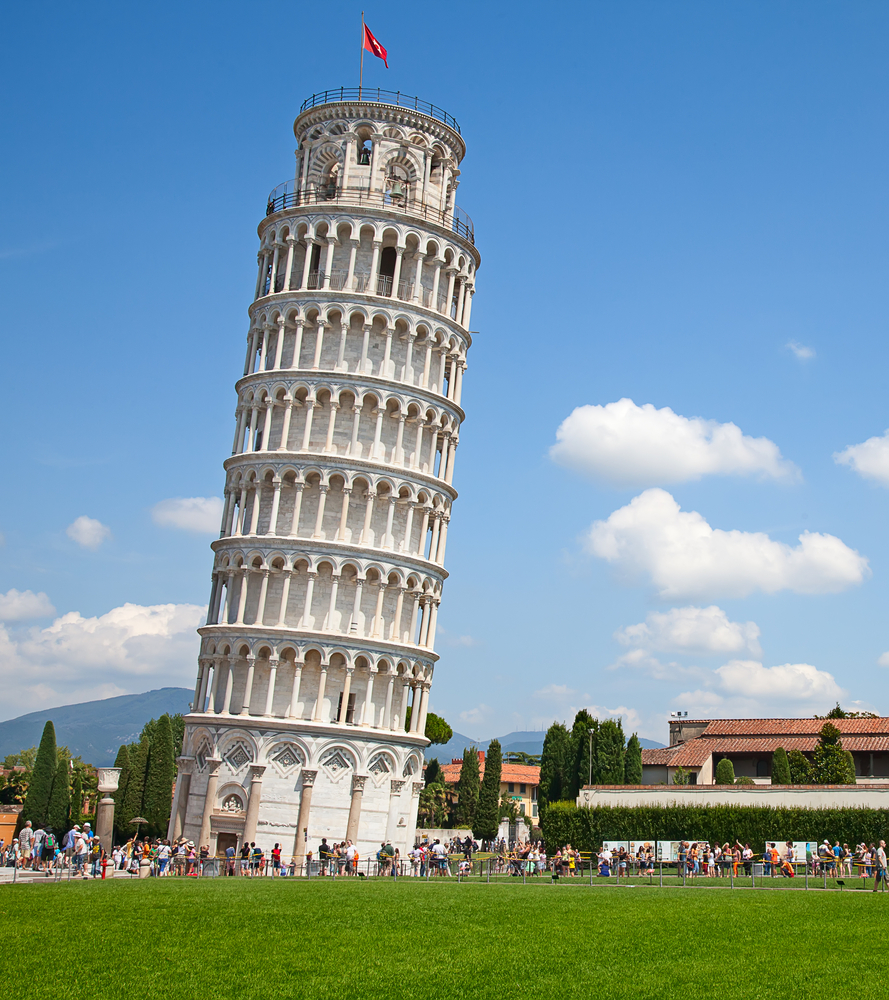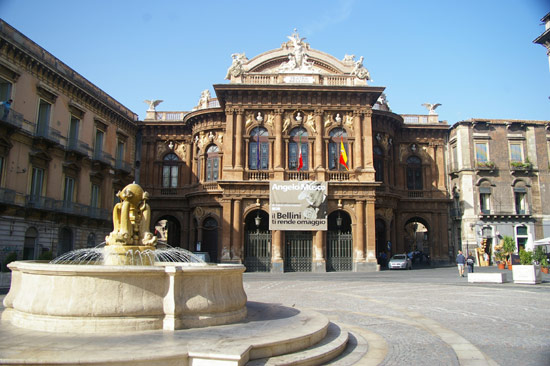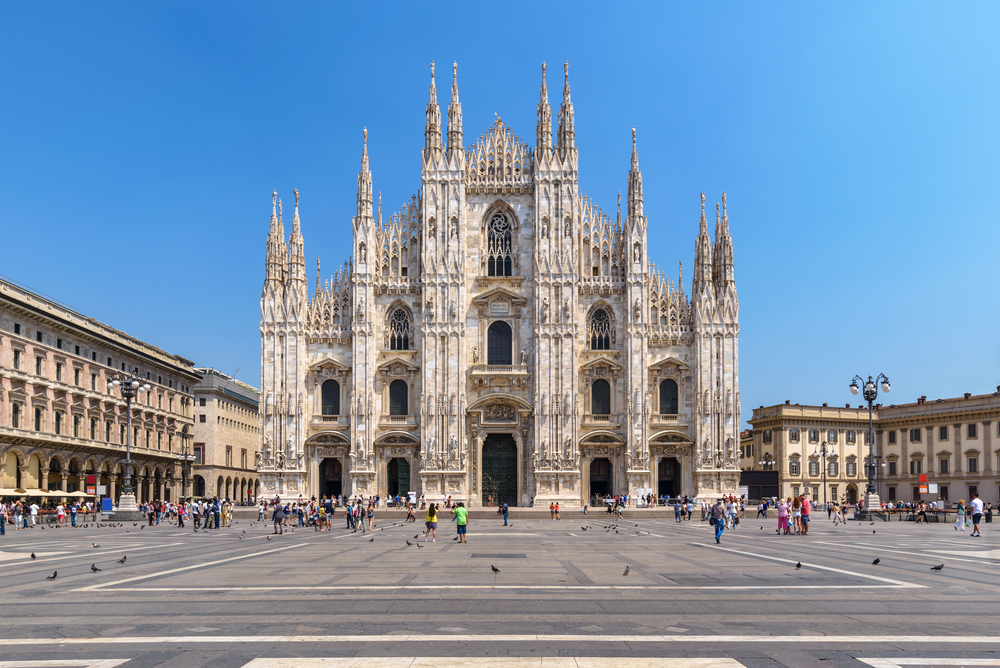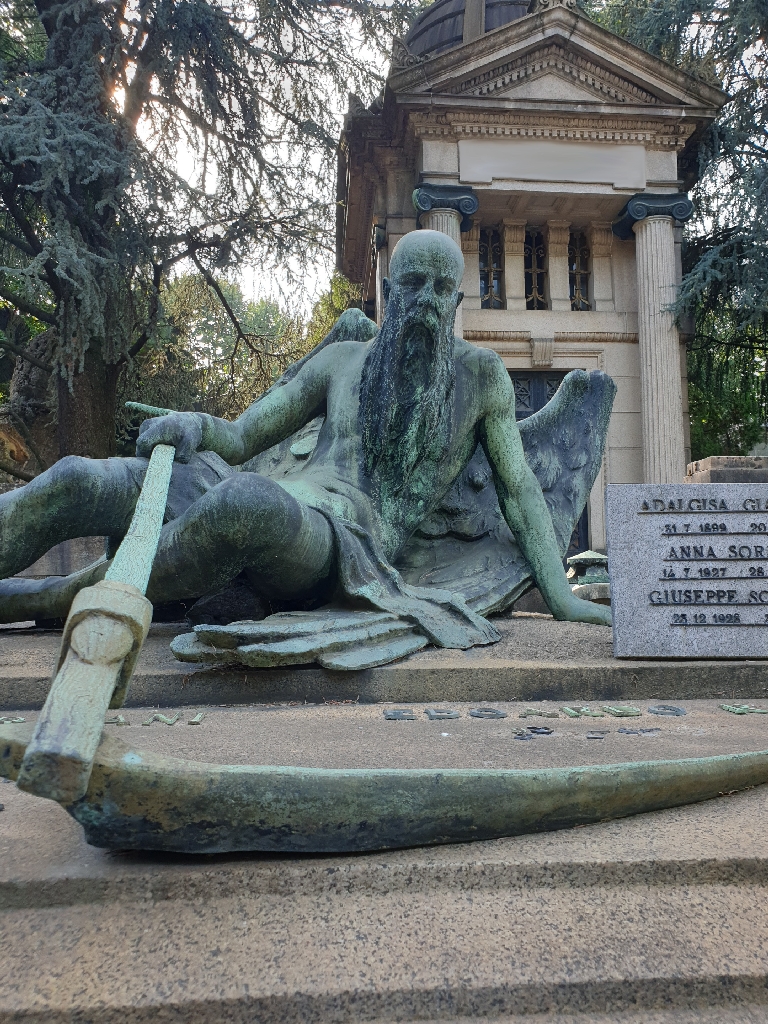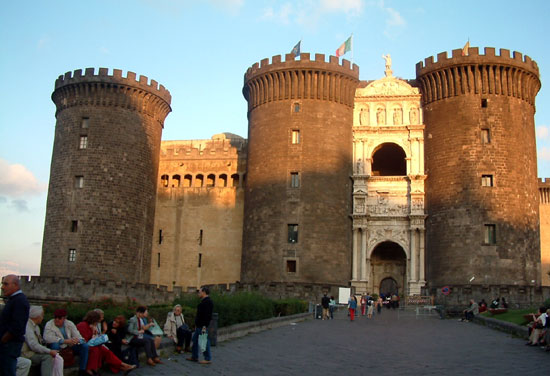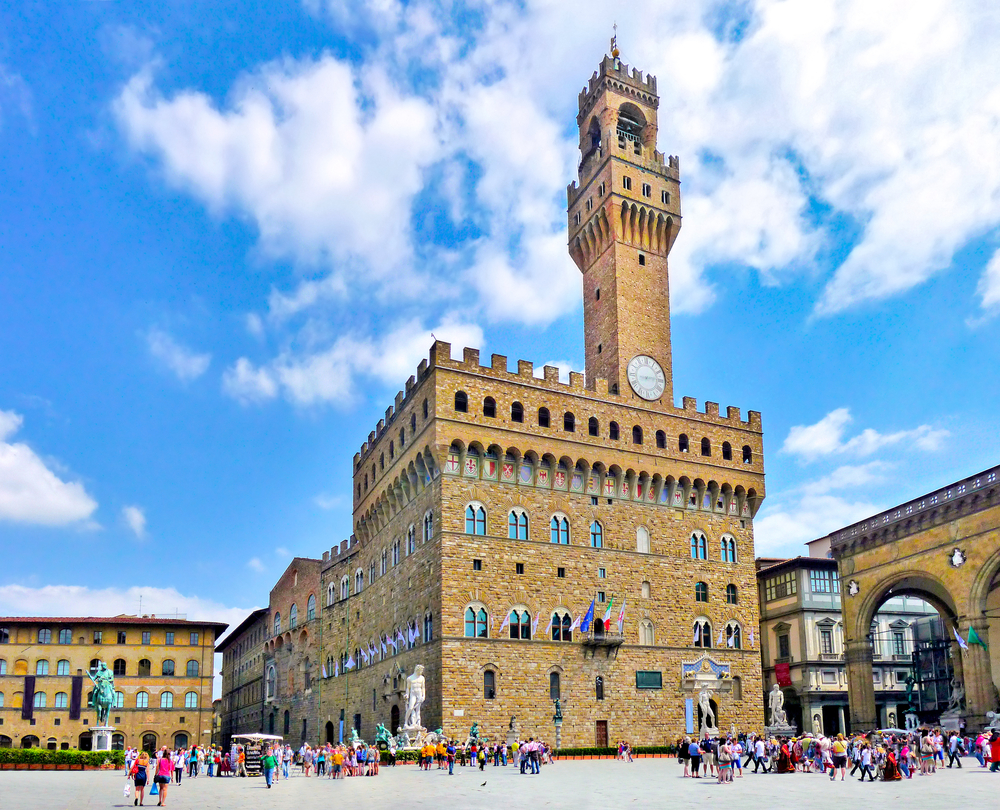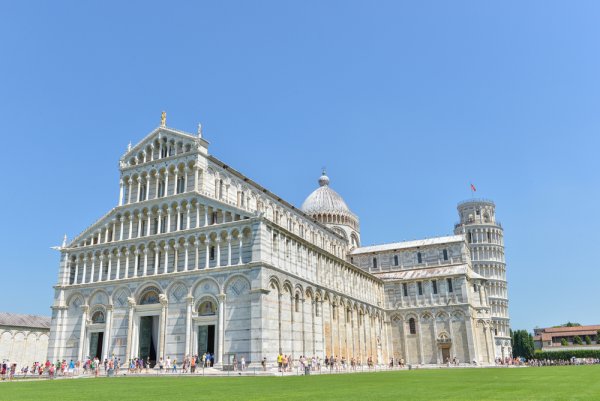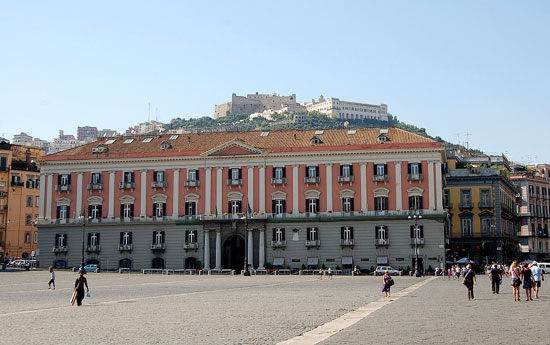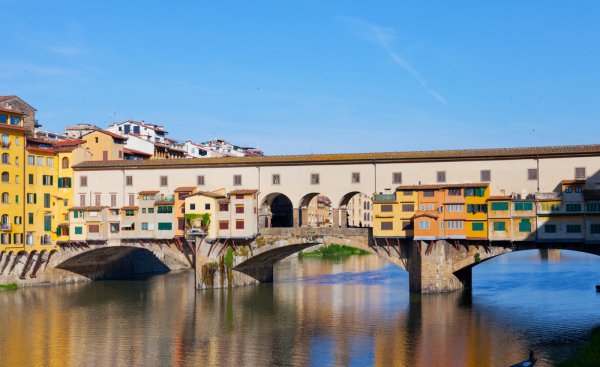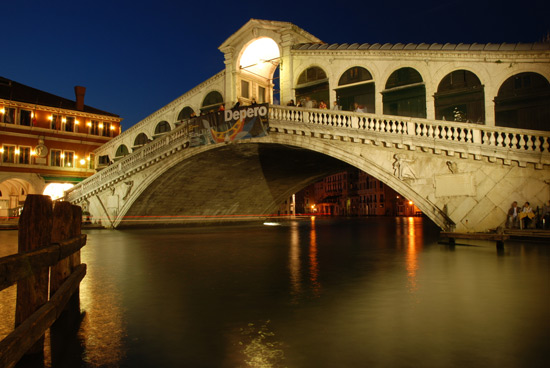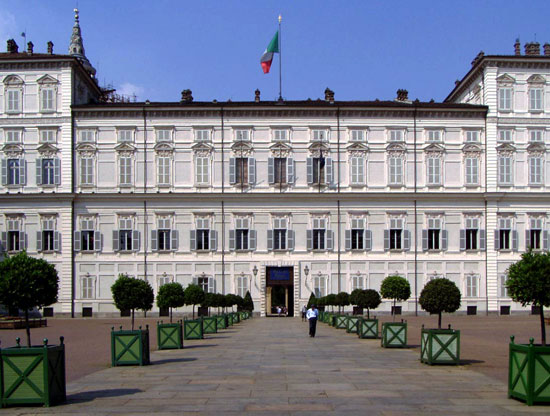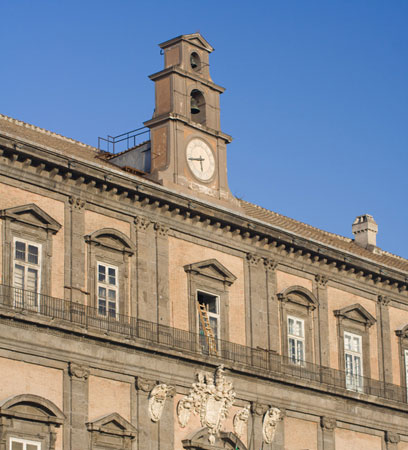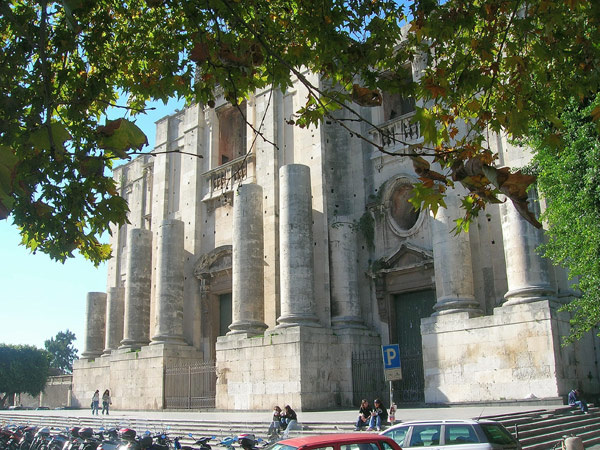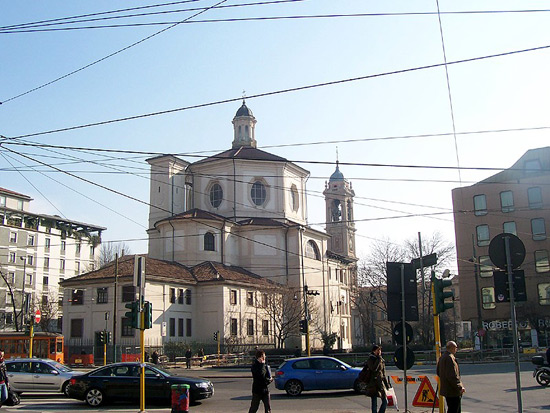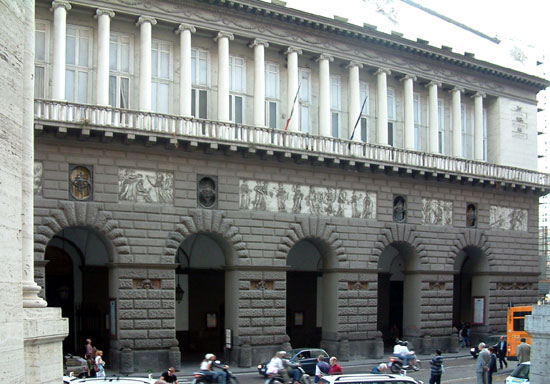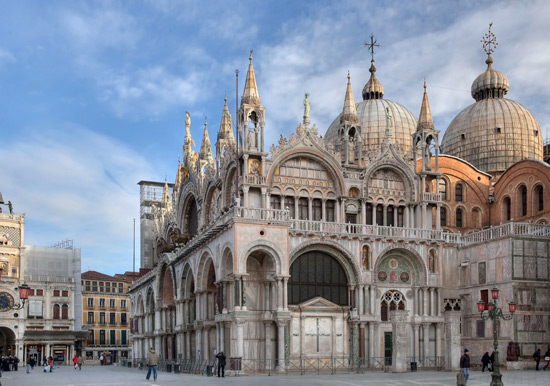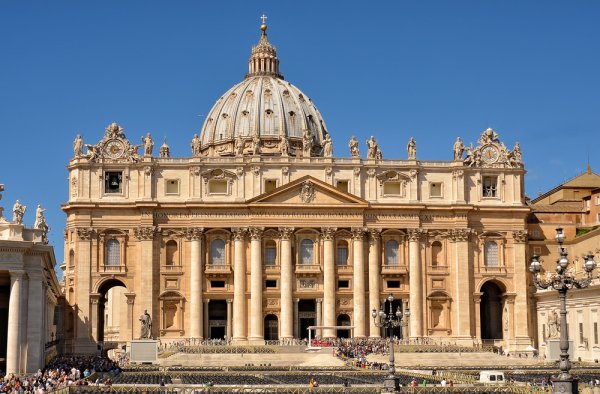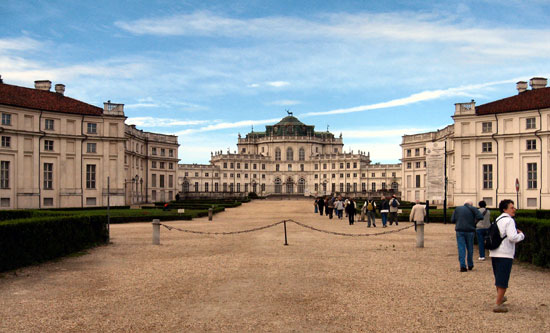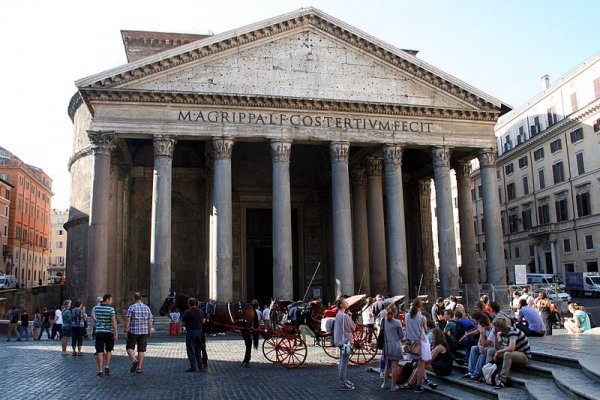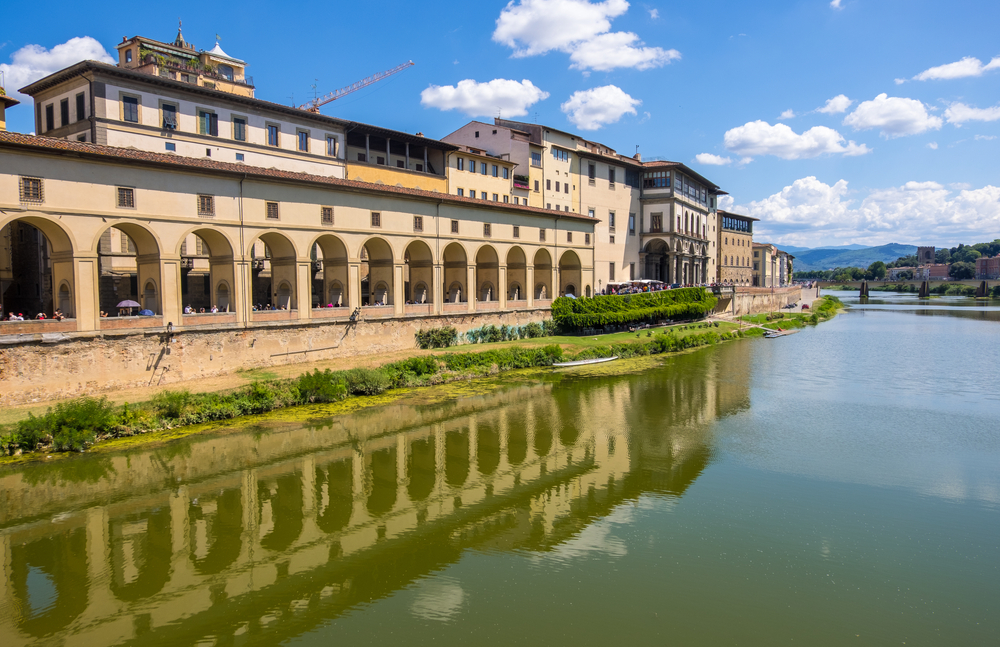Points of Interest
u Liotru
Elephant Fountain 1 Piazza Duomo
Catania, Italy
Standing atop an 18th-century fountain on Catania’s Piazza del Duomo, u Liotru is an elephant sculpture dating to Roman times carved from volcanic rock. According to written records of mid-12th century geographer Muhammad al-Idrisi, the locals of Catania revered an ancient basalt elephant called u Liotru because it possessed magical powers, including the ability to predict when nearby Mount Etna would erupt. Sicilian architect Giovanni Battista used the elephant as the centerpiece of his fountain, adding a marble saddle bearing an Egyptian obelisk and the coat of arms of St. Agatha, Catania’s patron saint. Today, u Liotru remains the symbol of Catania.
Bagatti Valsecchi Palace
Palazzo Bagatti Valsecchi 5 Via Gesù Via Santo Spirito 10
Milan 20121, Italy
The Barons Bagetti Valsecchi, to whom the palace once belonged, also assembled a vast array of Renaissance weapons, armor, clocks, and musical instruments, all of which are on display here. The attraction would not be Milanese if it didn't reflect Renaissance art. True to form, visitors can marvel over 15th- and 16th-century masterpieces by Bellini, Rizzoli, and Zenale.
Baptistery of St. John
Battistero di San Giovanni Piazza San Giovanni
Florence, Italy
Standing on the site of what was probably a Roman palace, the Baptistery was fashioned into its current eight-sided form in the 11th century. The Baptistery is ringed inside with ancient Roman columns, and both the floor and the ceiling are covered with intricate mosaic designs. Don't miss the doors to the Baptistery, specifically the north and east pair designed by Lorenzo Ghiberti. He was 22 when he won a contest to design the north doors in 1401. Today, many art historians focus on that date as the beginning of the Renaissance. Ghiberti spent the next 21 years creating the doors, and the result was so stunningly impressive that he was asked to do the east doors as well. He finished some 27 years later, just prior to his death, Years later Michelangelo declared the doors' beauty made them fit to be the Gates of Paradise, which is how they've been know ever since.
Basilica of San Clemente
Basilica di San Clemente al Laterano 95 Via Labicana
Rome 00184, Italy
The San Clemente Basilica was founded in a private home, sometime in the 4th century CE. This was a time of persecution for Christians, who were forced to practice their faith in secret. The present building was constructed in the 12th century, although the portico and several other features were added as late as the 19th century. The church features some outstanding mosaics, but most come to see the excavated remains of the earlier churches (and a pagan temple) that lay beneath. Through an entrance in the sacristy, visitors descend into the 4th-century basilica, built where the private home stood. On the lowest and oldest level is a 1st-century temple to the Roman god Mithras.
Basilica of St. Francis
Basilica di San Francesco 2 Piazza San Francesco Assisi
06081 Perugia, Italy
Construction for the Basilica of St. Francis began in 1228 by Brother Elia, a disciple of St. Francis. The beauty and splendor of this medieval masterpiece, which combines a high level of art and deep spirituality, ensure an emotional experience for art lovers and devout pilgrims alike. The crypt contains the venerated stone coffin of St. Francis surrounded by the graves of four disciples. Among the relics of St. Francis on exhibit here are a patchwork tunic, shirts, slippers, a letter signed by the saint, the rock used to rest his head in the coffin, and a few other belongings. The basilica also contains masterpieces by artists like Cimabue, Pietro Lorenzetti, Simone Martini, and Giotto.
Basilica of St. Mary of Health
Basilica di Santa Maria della Salute Fondamenta Salute, Italy
With its marshy air and close-packed houses, Venice in the Middle Ages was especially vulnerable to the plague. In 1630, after losing more than 45,000 residents, the city commissioned Baldessare Longhena to build a church to thank the Virgin Mary for saving Venice. Longhena, a pupil of Palladio, was a relatively young man when construction began in 1631. The project would outlast him and take more than half a century to complete. His church, known commonly as La Salute, is octagonal and made of stone quarried from Istria. The sacristy includes a little art gallery featuring works by Titian and Tintoretto. In the 17th century, the Senate would visit La Salute annually to offer thanks to the Virgin, and Venetians still come here on November 21 each year to give thanks for another year of health.
Basilica of St. Paul
Basilica Papale San Paolo fuori le Mura 1 Piazzale San Paolo
00146 Rome, Italy
This basilica, founded by Emperor Constantine I, stands over the burial place of St. Paul, where his followers had previously erected a cella memoriae (memorial). The structure, with a length of 131.7 meters (432 feet), width of 65 m (213 ft), and height of 29.7 m (97.5 ft), is one of the four great ancient churches in Rome. Over the years, the basilica underwent frequent repairs and extensions, and, under Gregory the Great (590–604), was further modified to place the altar directly over the tomb of St. Paul. In 1823, when a fire almost completely destroyed the basilica, many countries contributed to restoring it back to its ancient glory.
Basilica of Superga
Basilica di Superga Strada della Basilica di Superga 73
Turin, Italy
In 1706, Victor Amadeus II climbed this hill to look down upon the massive French army besieging Turin. If the city survived, he pledged, he would build a magnificent church dedicated to the Madonna. After Piedmont was saved by a Holy Roman Imperial army, the Savoy prince made good on his vow, commissioning this sumptuous hillside edifice. The architect was Filippo Juvarra, a Sicilian stage set designer whose particular brand of baroque architecture became fleetingly fashionable across western Europe. Along with containing the graves of more than 50 Savoy royals, the Superga hill also marks the spot of a 20th-century tragedy, when the airplane carrying the Torino soccer team crashed into it on a foggy day in 1949. The team was just four matches away from winning the championship and, as a mark of respect, the other Italian teams fielded youth players in the remaining matches against Torino.
Biscari Palace
Palazzo Biscari Via Museo Biscari 10
Sicily Catania 95131, Italy
This collection was originally amassed by aristocrat turned archaeologist Ignazio V, Prince of Biscari. After taking charge of the building of the new family palace (following the destruction of the old one in the 1693 earthquake), he was chosen to oversee the excavations at sites in eastern Sicily, including the Benedictine monastery of San Nicolò and digs at Camerina and Lentini. Many of the treasures he unearthed found their way into the Museo Biscari, including geological samples, Sicilian armor, and classical pieces such as statuary and medallions. Ignazio's taste earned him plaudits from art fans including Goethe, who visited the palace in 1787, just one of the Europeans doing the 18th-century Grand Tour. The interior is as remarkable as the collection, with a range of rococo artistry at work in elements such as the mirrors, stucco molding, chinoiserie, and frescoes.
Bridge of Sighs
Ponte dei Sospiri Palazzo Ducale San Marco
Venice, Italy
Not many prisons become literary celebrities, but this one did. The Ponte dei Sospiri was an enclosed limestone bridge built in 1600 by Antoni Contino to connect prison cells with the interrogation chambers in the Doge's Palace. Architect Contino had a bridge-building pedigree-his uncle Antonio da Ponte designed the Rialto Bridge. Two centuries later, Romantic poet Lord Byron turned this modest stone walkway into a heartbreaking architectural destination, with his poem "Childe Harold's Pilgrimage." Byron suggested that this was the last view of Venice for men condemned to jail. As they crossed the canal, they could look out of the barred windows and see their beautiful city for the final time. In reality, Byron's imagination was more graphic than reality: by the time he was penning poems, the Inquisition had disappeared, while the cells held only small-time thieves.
Castel Nuovo
Maschio Angioino Via Vittorio Emanuele III
80133 Naples, Italy
The sight of ancient castles is always impressive, no matter what age you are. Castel Nuovo is especially imposing, and it is located right in central Naples, in front of Piazza Municipio and city hall. The fortress and former royal residence that faces the Mediterranean Sea dates to 1279 and is one of the city’s most famous and important symbols. Meticulously restored over the centuries, today the castle includes the Municipal Museum of Naples, spread over two floors. Also inside is a prison, armory hall, chapels, bronze doors, sculptures, paintings, and much more. Your kids should be captivated imagining the history within these walls and the stories and legends they’ll hear about on their visit.
Castle of Rivoli Museum of Contemporary Art
Piazza Mafalda di Savoia Rivoli
Turin, Italy
This former royal residence of the House of Savoy is now one of Europe's foremost contemporary art spaces. The history surrounding the castle, from the negotiations surrounding medieval accession to the house arrest of Victor Amadeus II (at least until he had produced a male heir), lend the collection an aspect of historical permanence, even though the museum was only established in 1984. The roll call of artists is as impressive as Castello di Rivoli's aristocratic pedigree. Consider these names from the international art scene, featuring some of the most influential painters, photographers, and sculptors from the last 60 years: from America, Sol LeWitt, Nan Goldin, and Dan Graham; from Britain, Tracey Emin, Gilbert & George, and Tacita Dean; Germans Andreas Gursky, Thomas Struth, and Anselm Kiefer; Italian Francesco Clemente; Canadian Frank Gehry, Dutchman Jan Dibbets, Dane Olafur Eliasson, and South African William Kentridge.
Castle of the Holy Angel
Lungotevere Castello 50
Rome 00186, Italy
Hadrian constructed this five-story circular mausoleum in the 2nd century CE as his final resting place. It was converted into a military fortress in the early fifth century, to help defend the dying Roman Empire from the invading Visigoths. Rome fell, the Visigoths scattered Hadrian's ashes, and the building fell into disuse and ruin for centuries. It was converted in the late 1300s into Castel Sant'Angelo, a papal residence. It later became a notorious prison that was the setting for Puccini's Tosca.The Papal apartments are large and ornate. A circular interior ramp leads to the top floor, where a small café sells snacks and refreshments. The views of the Vatican City and the rooftops of Rome are splendid.
Catania University
Piazza dell'Università
Sicily, Catania 95131, Italy
Alfonso V of Aragon founded Sicily's oldest university in 1434, though it took several decades to organize the first few faculties. While the earthquake of 1693 wreaked havoc on the academic institution, it also gave the college an opportunity to construct a purpose-built structure, rather than continuing to use the former hospital of St. Mark's. As the students toiled in wooden huts beside the harbor, Palermo architect Giovanni Battista Vaccarini conjured a baroque vision in three-story stone. Look for the textured rusticated surfaces in the 1752 building, alongside the lava masonry, and the liberated use of human sculptural detailing in the putti. The university is located centrally on Via Etnea, just a stone's throw from the cathedral, making it easily accessible for visitors looking to see Vaccarini's work, the tiled courtyards, the cool cloisters, and the florid Basilica della Collegiata.
Cathedral of Santa Maria del Fiore
Duomo 1 Via della Canonica
50122 Florence, Italy
Too famous and majestic to miss, the construction of the Cathedral of Santa Maria del Fiore began in 1296. Designed in Gothic style, this is the third-largest church in the world, after Rome’s St. Peter’s Basilica and London’s St. Paul’s Cathedral. The nickname of Duomo derives from the enormous octagonal dome on the east end, while the structure itself is 153 meters (502 feet) long, 90 m (295 ft) wide at the crossing, and 90 m (295 ft) tall. Visitors will enjoy learning interesting facts, like how the dome remains the largest brick and masonry dome ever built and how skeptics thought it would collapse.
Today, the Duomo is recognized around the world as a symbol of both Florence and the Renaissance. There are ceiling and wall frescoes, detailed mosaics, and stained-glass windows by artists such as Vasari, Zuccari, Donatello, and Ghiberti. Also inside is the New Sacristy, where early Italian Renaissance statesman Lorenzo de' Medici took shelter in 1478 after he and his brother Giuliano were attacked (Giuliano was killed) while attending Mass. The views from atop the cupola are incredible, reached only after climbing 463 winding steps, which may be too much for little kids but prove a good challenge to older ones.
Cathedral of St. John the Baptist
Duomo di San Giovanni Battista Via XX Settembre 87 Piazza San Giovanni
Turin, Italy
It has been Turin's most celebrated icon for centuries: Sacra Sindone (the Holy Shroud), an enigma in linen. Thought to be the cloth that wrapped the crucified body of Christ, this length of linen has been debated and discussed virulently for hundreds of years. Even after the Catholic Church agreed to sophisticated carbon dating in the 1990s, the genesis of the shroud was not completely clear. Due to the relic's age, it is only shown every quarter of a century, though there is a permanent replica on display in front of the altar of this 15th-century cathedral (plus a museum, the Museo della Sindone, on nearby Via San Domenico). Outside this Renaissance structure designed by Meo del Caprina, look out for Turin's Roman remains, the old Porta Palatina gate, flanked by two towers.
Ca' Rezzonico
Dorsoduro 3136
Venice, Italy
This marble-fronted, three-story palace has been attracting visitors since construction started on its Grand Canal site in 1649. It was commissioned by the Bon family, who ran out of cash, but the Rezzonico clan stepped in and used their newly acquired mercantile wealth to complete the building process. It is one of the city's finest examples of Venetian baroque, and it now houses an enviable state collection of 18th-century art, including works by Tiepolo and Pietro Longhi, as well as Chinese vases and Dutch pottery from Delft. The palace was at one time owned by painter Robert Barrett Browning, whose poet father died here. Portrait painter John Singer Sargent had a studio in the building. Other celebrity guests who have stayed at the Ca' Rezzonico run the gamut from Pope Clement XIII to Elizabeth Taylor and Richard Burton.
Charterhouse of St. Martin
Certosa e Museo di San Martino 5 Largo San Martino
80129 Naples, Italy
There is much to see and admire at this former monastery, from its museum full of artifacts and the hanging gardens, to the view from its Vomero hilltop setting. Take the funicular at Montesanto station to get here then wander the grounds and admire the chapel’s intricate exterior. Inside are the painted ceilings and marble alters that amount to what some say is the most beautiful church in the city. Kids will see boats, model ships, swords, pistols, and much more in the museum. Adults will appreciate the 17th-century paintings and collection of presepi (nativity scenes). The views from outside offer all of Naples below, including Mount Vesuvius and the Gulf of Naples. Once you’ve taken your share of outstanding photos, wander the Vomero neighborhood and shop, grab a bite to eat, and finish off with some gelato.
Church of Saint Minias on the Mountain
Via delle Porte Sante
Florence, Italy
Construction began in the early 11th century and is a particularly striking example of Florentine Romanesque architecture, with a façade of inlaid green and white marble in geometrical designs. Among the wonders inside is the Cappela del Cardinale del Portogallo (Chapel of the Cardinal of Portugal), which was built to honor Cardinal Jacopo di Lusitania, known for his devotion to the church and humanist philosophy. Be sure to take a long look at its glazed terra-cotta dome, created by Luca dell Robbia, which depicts the four Virtues surrounding the Holy Spirit.
Church of San Fedele
Chiesa di San Fedele Via Ulrico Hoepli 3
Milan, Italy
Unlike the sometimes extravagant elegance of its Renaissance counterparts, San Fedele is a Jesuit church designed in austere fashion and enlivened only by the odd baroque touch. This tribute to Fidelis, the patron saint of the Como diocese, was the brainchild of uber-architect Pellegrino Tibaldi, who impressed Cardinal Borromeo with his ability to interpret the subtle aesthetic themes of the Counter-Reformation. The interior's column-supported single nave contains mannerist paintings by the likes of Peterzano, Crespi, Figino, and Fontana; baroque confessionals; and carved choir chairs transported here from the Santa Maria della Scala before its conversion into the opera house.
Church of San Giorgio Maggiore
Chiesa di San Giorgio Maggiore Isola San Giorgio Maggiore
Venice, Italy
The view of this striking white island church from St. Mark's Square is delightful, but it's not half as pretty as the corresponding outlook from the bell tower of San Giorgio Maggiore itself. Take a vaporetto out to the island for one of Venice's most charming churches. (Claude Monet was an admirer, and painted an oil canvas of it.) Andrea Palladio was commissioned to design it, and he began construction in 1566. The church is a beautiful example of Palladio's strict architectural principles, reflecting the mathematical harmonies of the great Renaissance architect. San Giorgio Maggiore may be relatively spartan inside, but it does contain a handful of top-class paintings, including two works by Tintoretto (The Last Supper and Fall of Manna), as well as works by Sebastiano Ricci and Jacopo Bassano. Finish your visit by taking the elevator up the bell tower.
Church of St. Agatha of the Prison
Via Colosseo
Sicily, Catania, Italy
This Old Town church dates back to the 12th century, although the classical front is an 18th-century addition, courtesy of the great earthquake of 1693. It was built, legends say, on the location of the prison cell occupied by the saint herself. Agatha was a well-born Sicilian lady who refused the advances of a Roman officer. Enraged, he demanded that she pay tribute to Rome's gods and, when she refused, he tortured her by cutting off her breasts. Today, Agatha is remembered as the patron saint not only of Catania, but also of women with breast cancer, bakers, and bell-founders. If the church is open, it may be possible for visitors to ask the custodian if they can see the claustrophobic cell where Agatha was incarcerated before her death. Look out too for the medieval gate (reputedly that of the cathedral), the animal sculptures atop the columns, as well as two volcanic rock slabs, which show the saint's tiny footprints.
Colosseum
Colosseo 1 Piazza del Colosseo Rome
00184 Lazio, Italy
One of the most famous monuments of the Roman Empire and an iconic symbol of Rome, the Colosseum is a huge amphitheater that measures over 49 meters (160 feet) in height and has a seating capacity of 50,000. Inaugurated in 80 CE, the Colosseum was the center of all public entertainment, including gladiatorial games, animal hunts, executions, mock battles, and dramas, until the 6th century. It eventually fell out of use during the early medieval era. Over the years, the Colosseum was used as a fortress, quarry, Christian shrine, and quarters for a religious order. The Colosseum has close ties with the Roman Catholic Church and hosts the annual Good Friday "Way of the Cross" procession.
Coppedè Quarter
Quartiere Coppedè Piazza Mincio
Via Tagliamento
Rome 00198, Italy
In the northern part of Rome, Quartiere Coppedè features a mix of many different architectural styles, all by Florentine architect Gino Coppedè who worked on the quarter from 1919 until his death in 1927. Referred to as the city’s architectural fantasy quarter, it includes ancient Greek, Roman Baroque, Mannerism, medieval, and Art Nouveau styles. Used as a setting in a number of films, Quartiere Coppedè has around 40 structures that include a sundial, fountain, mosaics, frescoes, and palazzi. Particularly notable is a music-themed building with exterior ironwork and carvings that imitate musical notation.
Doge's Palace
Palazzo Ducale 1 San Marco Venice
30124 Veneto, Italy
Doge's Palace is a Gothic-style palace constructed from 1309 to 1424, although its foundations are thought to date back to the 9th century. The palace, the official residence of the Doge (Chief Magistrate) of Venice, houses lawyers' offices, office of the Chancellery, office of the Censors, naval offices, the Grand Council Chamber, and the Ballot Chamber, spread over the first and second floors. The third floor is decorated with paintings, including those of previous Doges, and usually reserved for hosting foreign ambassadors. Tintoretto's Vast Paradise, the world's largest painting on canvas, can also be seen in the Grand Council Chamber.
Domus Aurea
Viale della Domus Aurea 1
Rome 00184, Italy
Everyone knows the story of how Nero fiddled while Rome burned. Less well known is that once the fire was put out, he cleared much of the burned out Esquiline Hill to construct his Domus Aurea, or House of Gold. This enormous estate, Domus Aurea covers more than 100 acres. It features grand reception halls, dining rooms, and sleeping chambers for hundreds of guests. The grounds of the estate include formal gardens and Colosseum. Nero enjoyed his pleasure palace for only a few years before dying in 68 CE. Buried and forgotten for centuries, it was rediscovered during the Renaissance.
Elephant Fountain
Piazza del Duomo
Sicily, Catania, Italy
It isn't clear why elephants are so synonymous with Catania. Some claim that pygmy versions of the giant mammals once lived in this region. Others cite a disgraced citizen named Heliodorus (Liotru in Sicilian dialect, a word that now means elephant) who is remembered in the form of an elephant. Others state that the elephant protects Catania from the volcanic lava of Mount Etna. Whichever myth or legend visitors believe, it's clear that this Sicilian city is elephant-crazy. Its City Hall is even nicknamed Palazzo degli Elefanti (Palace of the Elephants) because of the tiny pachyderms carved into the stone relief work. Catania's most famous tusker is situated in front of the cathedral. Constructed of volcanic basalt, the elephant sits atop a marble plinth and carries an obelisk from the Egyptian city of Aswan. Vaccarini designed it in 1737.
Galleria Umberto I
Via San Carlo
Naples, Italy
Built in the mid-1800s in an effort to "resanitize" Naples and clean up its act, this beautiful building is enclosed with an iron and brass design reminiscent of the Industrial Revolution, yet its domed ceilings and intricate detail retain the elegance of the city's architecture. Since its establishment it's been injured and repaired repeatedly (it took a hit by Allied bombers) and establishments have come in and out. While some businesses remain, the majority of the traffic the gallery sees is passers-through, and it's a relatively quiet place to absorb an architectural marvel.
Giorgio Franchetti alla Ca' d'Oro Gallery
Cannaregio 3932 Venice Italy
Giorgio Franchetti alla Ca' d'Oro Gallery is housed in the historic Palazzo Santa Sofia. Commissioned by the Contarini family, the Palazzo Santa Sofia became known as Ca' d'Oro (Golden House) because of the gilt facings to its marble walls. It was designed by father and son Giovanni and Bartolomeo Bon, who were also involved in sculptures in the Doge's Palace. The Contarinis were something of a Venice institution, siring no fewer than eight doges for the city between the 11th and 17th centuries. Alas, a later owner was less respectful of this building's Venetian Gothic design. After ballerina Marie Taglioni was gifted the palazzo by a smitten Russian prince, she ripped out the stairway in the elegant inner courtyard. Ca' d'Oro is now owned by the state, thanks to its final owner, Baron Giorgio Franchetti, who gave his name to the museum containing paintings by Giorgione, Titian, Guardi, as well as Andrea Mantegna's celebrated St. Sebastian.
Great School of San Rocco
Scuola Grande di San Rocco San Polo
3052 Venice, Italy
The religious confraternity of St. Rocco became the richest in all of Venice. Combining the socializing and commercial back scratching of a gentlemen's club with the donation and giving of a charity, the scuole were powerful organizations in the city. This one was dedicated to St. Rocco, a plague survivor whose fortitude attracted both followers and riches. Though the architecture is interesting for its typical layout, the Scuola di San Rocco's chief attraction is its wealth of work by Jacopo Robusti, a.k.a. Tintoretto. The native Venetian used a wily ruse in a 1564 competition for a ceiling commission. He presented the confraternity not with his prospective sketch, but with a finished work, which he handed over at no cost. His generosity was to be repaid many times over. Tintoretto and his assistants later painted more than 20 works covering three chambers.
Historic Center of Rome
Rome, Italy
Believed to have been founded in 753 BCE, Rome was the center of the Roman Republic and the Roman Empire, and it was acclaimed as the center of the Christian world by the 4th century. Some important monuments of ancient Rome include the Colosseum (the largest amphitheater of the Roman Empire), Roman Forum, Pantheon, Catacombs of Rome, and the Pyramid of Cestius. Equally famous are the vast and regal squares and the obelisks (shafts of stone with a tapering end on one side) built in the 17th century. The old city has about 200 palaces, 900 churches, 300 hotels, eight major parks, the president's official residence, offices of the government, and innumerable well-known monuments.
Holy Mary of Grace Church
Santa Maria delle Grazie Piazza Santa Maria delle Grazie 2
Milan, Italy
The gorgeous, Bramante-designed luminous tribune of this church is almost as impressive as the masterpiece contained in its former refectory, Leonardo da Vinci's fresco The Last Supper, depicting the moment when Jesus learns of his betrayal. The figure of Judas is positioned to the right, his hand over a bag of silver. Miraculously, the painting survived the bombing of the refectory's roof in World War II. More recently it was the subject of a controversy concerning corrective overpainting (and figured heavily in a work of popular fiction bearing Leonardo's toponym in the title). Scaffolding permanently blocks the view of the lower part of The Last Supper, but the rest is easily visible. Reservations for visits are essential and you should arrive a quarter of an hour before the scheduled start time.
Leaning Tower of Pisa
Torre de Pisa Piazza del Duomo
56126 Pisa, Italy
Located in the Field of Miracles (Campo dei Miracoli), the Tower of Pisa is the bell tower of a cathedral in Pisa. The construction of the Tower of Pisa began in 1173 and proceeded in three stages until its completion in 1372. The inclination of the Tower to the southeast due to a poor foundation and loose substrate has actually enhanced its splendor. Nevertheless, an international team of engineers, mathematicians, and historians were called in to stabilize the Tower in 1989. After the corrective reconstruction effort was completed in 2001, the leaning Tower of Pisa has been declared stable for the next 300 years.
Lingotto
Oval Lingotti Via Nizza 294
Turin, Italy
Originally a car factory, this building is no ordinary one. It was to be the pinnacle of automotive engineering. Designed by naval engineer Giacomo Matte' Trucco in 1921, the five-storied Fiat factory was divided by manufacturing process. So raw materials entered the factory at the base, engine machining took place on the first floor, gear box work on the second floor, and so on until the final story took the roof off, literally. On top of the factory is the Fiat test track, a wondrous oval on which the engineers could see immediately the practical implications of their theoretical designs. Another Italian architect, Renzo Piano, won the commission to redesign the decommissioned factory in the 1990s. His vision was to draw the Lingotto back towards the city, envisioning an exhibition center, hotels, retail space, bars, and restaurants. Don't miss Pinacoteca Giovanni e Marella Agnelli, the Agnelli family's personal art collection, which includes priceless works by the likes of Matisse, Canaletto, Renoir, and Modigliani.
Madama Palace
Palazzo Madama Piazza Castello
Turin, Italy
Combining artworks from a thousand years of European history, this substantial collection of 30,000 pieces includes decorative arts such as jewelry, fabrics, glasswork, ceramics, and work in ivory, as well as traditional painting and sculpture. Established in 1861 by the city, the ancient art collection is not only a repository for Piedmontese heritage, but also an educational institution to enable generations of artisans to learn from their forebears. Across four stories, visitors can unearth gems from the Lapidario Medievale (medieval stonework collection) in the basement to the baroque furniture on the first floor. Even the building that houses these works is a collector's item. Nicknamed Palazzo Madama for its 17th-century occupant, Savoy ruler Maria Cristina, the palace has its own fascinating history. Make sure you compare the front, with its baroque classical façade by Filippo Juvarra, with the crenellated rear, originally built as a castle.
Mássimo Bellini Theater
Via Giuseppe Perrotta 12
Sicily, Catania, Italy
Although the foundation stone for this grand theater was laid in 1812, the doors were not opened to the public until 1890 (with a performance of Bellini's Norma). Given that Catania had to battle cholera outbreaks during this period, perhaps it isn't so surprising. Designed by Milan architect Carlo Sada, Teatro Mássimo Bellini seats 1,200 spectators, with an orchestra numbering 105 and a choir totaling 84. Despite the fact that it was mostly built in the late 19th century, its baroque design matches the 17th- and 18th-century structures around it. The theater has hosted many of Italy's most renowned performers, as well as international stars. Among the roster of musical legends to have played or conducted here are Maria Callas, Georg Solti, and Riccardo Muti. The list of musical directors is equally accomplished, featuring cinematic luminaries Franco Zeffirelli and Werner Herzog.
Milan Cathedral
Duomo di Milano Piazza del Duomo
20122 Milan, Italy
Whether you simply tell the kids, “They don’t make ‘em like that anymore,” or that the construction of the Milan Cathedral began in 1386 and took nearly 600 years to complete, this beautiful sight should impress the whole family. The cathedral, called the Duomo, played a significant role in spreading the Christian faith and establishing Catholic traditions of worship. Measuring 157 meters (515 feet) long, 92 m (302 ft) wide, and more than 106 m (350 ft) high, the 40,000-seat capacity Milan Cathedral is the second-largest church in Italy (next to St. Peter's Basilica) and the second-largest Gothic cathedral in the world (after the Cathedral of Seville in Spain). The cathedral's numerous monuments and artworks include three superb altars, the St. Bartholomew statue by Marco D'Agrate, the tombs and sarcophagi of many archbishops, and other architectural masterpieces. Guided tours are available, and rooftop views of Milan are worth the small fee.
Modena Cathedral
Duomo di Modena Corso Duomo Modena
41121 Emilia-Romagna, Italy
Work on the Modena Cathedral started in 1099 over the tomb of St. Geminianus, the patron saint of Modena, whose remains are still on display in the cathedral's crypt. The majestic facade of the cathedral includes portraits of prophets and patriarchs, as well as Romanesque sculptures depicting biblical stories like the creation of Adam and Eve, the Fall of Man, and the story of Noah. The splendid interior of the cathedral portrays the Passion of Christ and the Last Supper in marble. The pulpit is adorned with terracotta statuettes and a wooden crucifix that dates back to the 14th century. This structure, with its soaring towers and piazza, is an outstanding example of Romanesque architecture.
Monumental Cemetery of Milan
Cimitero Monumentale di Milano Piazzale Cimitero Monumentale
Milan, Italy
Though a cemetery may not be the first place you think to visit when seeking art and sculpture, Milan’s Cimitero Monumentale di Milano should be considered nonetheless. The cemetery is one of Milan’s two largest, covering 5,000 square meters (about 53,800 square feet) and is noted for its large amount of artistic tombs and monuments. Included is a large, central mausoleum called the Famedio (Temple of Fame), home to some of Milan’s honored citizens. The Famedio’s beauty includes its architectural style, gothic rose window, and decorative floral and geometric designs. A stroll around the cemetery grounds offers life size sculptures of angels, soldiers, figures representing death, faith, and Greek gods, skulls, flowers, crosses, and more. There is an area dedicated to notable mountaineers and hikers, including a bas relief of a mountain landscape. A quiet and peaceful area shaded by large trees, a stop to the Monumental Cemetery allows for introspection and for pondering the lives of its inhabitants, as well as for admiring the cemetery’s unlikely art.
Monumental Complex of St. Clare
Complesso Monumentale di Santa Chiara Via S. Chiara 49
Naples 80134, Italy
Standing tall, stark, and intimidating, this Gothic building dates back to 1310 and is one of the city's oldest and most revered religious symbols. During the baroque revolution in the early 1700s, the building got a robust makeover, and its cloister (Chiostre della Clarisse) was furnished with the now-signature Neapolitan blue, green, and yellow majolica tiles that reflect the landscape of sky, grass, and lemon tree. Sadly, Allied forces hit the church and cloister during World War II, resulting in a major loss of the original Gothic features. However, since its restoration over the last century, the basilica and cloister have been restored to their former glory, and the complex houses museum rooms dedicated to the structure's long history, the site's archaeological findings, nativity scenes (presepi), marble, ruins, and reliquaries.
Naples Cathedral
Duomo di Napoli 149 Via Duomo
Naples, Campania. Italy
With a façade similar to the Notre Dame de Paris, the Duomo is Naples' and southern Italy's mother church and the seat of the archbishop of Naples. It is also known as the Cathedral of St. Januarius, Naples' patron saint, whose remains were transferred here from the Catacombs of St. Januarius. Three times a year a vial of St. Januarius' dried blood is brought out to the public, at which point it miraculously liquefies. Like many things religious in Naples, the Duomo was built in the 13th century and later adorned with baroque inspiration. But the church site dates back farther, to the 4th century, when the Basilica de Santa Restituta was built. Of the various chapels incorporated into the whole of the cathedral is the Cappella di San Gennaro, which, with its lavish baroque design, is considered one of the finest examples of Neapolitan Baroque. Be sure not to miss the 13th-century reliefs, 14th-century mosaics, and the Baptistery di San Giovanni, which, dating back to the 4th century, is the oldest baptistery in the West.
New Castle
Castel Nuovo / Maschio Angioino Piazza Castello
Naples, Campania, Italy
This terrifyingly huge fortress, originally built for the first king of the Angevin Dynasty in the 1200s but expanded in the 15th century, is one of Naples' most representative images. As Castel dell'Ovo and Castel Sant'Elmo had been in use by previous rulers, the Angevins felt the need to create something new and presumably more strategic and scary-looking to would-be invaders. Like the crusader palaces across Europe, the "new castle" features crenellated cylindrical stone towers-five of them-and a triumphal arch. Nowadays this formidable structure houses some of the finest art and artifacts of its treasuries (and of other local monuments) in its resident Museo Civico (Civic Museum). Visit the Cappella Palatina for part of the museum's exhibit and to step inside what remains of the original castle.
Palazzo Vecchio
Piazza della Signoria
50122 Florence, Italy
Noted as one of the city’s most family-friendly museums, Palazzo Vecchio showcases how the wealthy lived centuries ago. Plan to book a guided family tour of the Palazzo Vecchio in advance, as kids should enjoy the costumed guides, activities, puppet shows, and scavenger hunts. A secret passage leads to a room where they can dress up in royal children’s clothing. Tours and activities take one to two hours. Parents will find sumptuously decorated rooms and panoramic views from the walkway and 95-meter-tall (311-foot-tall) tower. The second floor features Donatello's Judith and Holofernes, one of his last bronze masterpieces, and on some summer evenings the outdoor balustrade on the roof is open, offering a terrific view of the city in all directions.
Piazza dei Miracoli
Piazza del Duomo Pisa
56010 Tuscany, Italy
The Piazza dei Miracoli (Square of Miracles) is a vast walled area housing four famous religious masterpieces of medieval architecture. At the center of the field is the Duomo, a medieval cathedral dedicated to St. Mary, and facing the western end of the Duomo is a baptistry dedicated to St. John. At the northern corner of the Piazza is the Camposanto Monumentale (Monumental Cemetery), claimed to be the most beautiful cemetery in the world. The fourth monument, the Leaning Tower of Pisa, stands behind the cathedral.
Piazza Plebiscito
Piazza del Plebiscito
80132 Naples, Italy
A large public square, Piazza Plebiscito is a gathering spot for Naples’ residents, where they come to stroll, chat, and let the kids play. The expansive open space includes some of the city’s major monuments and architecture, including the royal palace, the domed Basilica of San Francesco da Paola, and the pastel-colored Palazzo della Prefettura and Palazzo Salerno, one located on each side of the piazza. Enclosed by a curving row of columns, the scenic area conveys the city’s grandeur and includes bronze equestrian statues that will make for fun photos of the kids. Various concerts and events are held here throughout the year or just wander through the narrow streets and people watch. Before you leave the area, stop by the historic Gran Caffe Gambrinus in the corner to grab some coffee and pastries, or stay to admire this coffeehouse that was a haven for the city’s residents, intellectuals, and politicians, dating to 1860 and including decorative ceilings.
Piazza Stesícoro
Via Etnea and Via Pietro Garofalo Sicily Catania
Sicilia, Italy
Situated astride Catania's main street, Via Etnea, is this extraordinary square. There's an imposing statue of composer Vincenzo Bellini, the Chiesa di San Biagio (sometimes known as Sant'Agata alla Fornace, or St. Agatha of the Furnace, a reference to the fiery torture Agatha endured), and one of Catania's archaeological gems-the Anfiteatro (Amphitheater). Dating from the second century, this stepped arena was where Saint Agatha was reputedly tormented. Though the marble facing on the seats has been worn away to reveal the volcanic masonry beneath, the order and architecture is plain. The section preserved on the west side of Piazza Stesícoro (admission free, closed Mondays) is only a segment of the original amphitheater-a painting on the site shows how the Roman arena would have looked when it was full of 16,000 spectators. Compare that with the Stadio Angela Massimino, contemporary Catania's soccer stadium, which would be lucky to attract similar numbers 18 centuries later.
Pitti Palace
Palazzo Pitti Piazza de Pitti
Florence, Italy
The palace was originally built in 1458. After it was bought by the Medici family in 1549, they immediately began to expand the place, and expansion became its perpetual condition for the next 300 years as succeeding Florentine ruling families occupied the space. It became state property in 1919, and today houses an amazing and varied collection of artwork in its myriad rooms. A particular favorite for many is the Galleria Palatina (Palatina Gallery), a huge space with well-known paintings by Raphael, Tintoretto, Rubens, and Titian, among others. There is also a Costume Gallery and a Porcelain Museum, among others. Directly adjacent to the palace are the expansive Boboli Gardens.
Ponte Vecchio
Florence, Italy
The Ponte Vecchio is a medieval bridge in Florence built over the Arno River. Originally made of wood during the Roman times, the bridge was rebuilt in stone in 1345 after a flood destroyed the first one. Ponte Vecchio is Europe's oldest, all-stone, segmental arch bridge. A distinctive feature is the row of shops built along the length of the bridge, where merchants set up shops after authorization from the bargello (mayor). In recent times, these have mostly been jewelry stores.
Rialto Bridge
Ponte di Rialto Connecting Ruga dei Oresi and Salizzada Pio X San Polo
Venice, Italy
The commission to plan a stone bridge across the Grand Canal attracted the most famous designers in Italy, including Andrea Palladio and Michelangelo. But Antonio da Ponte got the job, and it's his bridge that still stands as one of Venice's most photogenic landmarks. Previously, wooden bridges spanning the canal would open and close to admit shipping. With da Ponte's construction, that was no longer possible (though low galleys could still pass). The resulting bridge changed the demographics of the Grand Canal, shifting it from a mercantile district to one filled with palaces. Trade didn't completely dry up, however. The Rialto Bridge leads directly to Venice's ancient business district, including Ruga degli Oresi (Street of Goldsmiths), with the tax collection building also nearby. Da Ponte's plan included space for shops on the bridge-the shops here still do brisk business today.
Royal Palace
Palazzo Reale Piazzetta Reale 1
Turin, Italy
The exterior of this regal palace (created by the Count of Castellamonte) is sturdy, even stolid, an austere entrance to something far fancier. Only when visitors go inside does the palace's baroque lineage become clear, with room after room of monumental artworks. Climb the impressive staircase (designed by Domenico Ferri), wander around the cavernous Salone degli Svizzeri and admire the friezes by the brothers Fea, or marvel at the sculptures of the Throne Room. The sheer scale of the place and the amount of patronage on show illustrates how the royal House of Savoy could keep a city of artisans working over three centuries. Almost forgotten outside are the Royal Gardens, laid out in 1697 by André le Nôtre. And don't miss the Armeria Reale (Royal Armory), with its collection of inlaid weapons, 16th-century armor, and Japanese battle masks.
Royal Palace of Naples
Palazzo Reale 1 Piazza del Plebiscito
Naples 80132, Italy
Commissioned in 1600 and finally finished in 1843, this sprawling palace stands for the opulence of the Bourbon rulers. Now a museum and a testimonial to Naples' vibrant history, the palace has 30 rooms open for tours, each one more extravagant than the next. Visit the throne room, the king's study (which holds a desk and other furniture made for Napoleon), and marvel at the multitude of rooms that display marble, gems, gold, and artwork by such masters as Giordano and Vaccaro. The Royal Palace also houses the National Library, one of Italy's finest institutions, which contains approximately 1.5 million printed volumes and 1,800 Herculaneum papyri.
Saint Elmo Castle
22 Via Tito Angelini
Naples, Campania 80129, Italy
While there's little to see inside this hulking fortress on the hill of Vomero, it's got the best views in town. Built (like so much in Naples) in the 13th century by the Angevins and developed into its current star shape in the 16th century, the fortress' long history has seen the presence of royalty, military, and prisoners. Today it sees mostly tourists, who scale its stony walls (or, more accurately, take the elevator) to absorb views out to the end of the Sorrentine peninsula, Vesuvius, the Bay of Naples, and beyond. Future plans may involve turning it into an arts and performance center.
Saint Nicolas Arena Church
Piazza Dante
Sicily, Catania, Italy
The monastery complex of Saint Nicolas is named for the sandy soil that permeates this part of Catania. Construction started in 1687 under the guidance of architect Giovanni Battista Contini, but the earthquake of 1693 wrecked the site, and it took another 20 years before building began again. Francesco Battaglia took up the reins of the project in the 1730s, and the complex started to take shape, but the city ran out of money, which explains the eight columns that reach up to an imaginary pediment, which was never added. Saint Nicolas' frontage may look like a broken comb, but what it lacks in finish, it makes up in sheer scale. Visitors who come on a Thursday or a Sunday still marvel at the length of the 105-meter (340-foot) nave, the 62-meter-high (205-foot-high) dome, and the size of the adjacent convent, the second largest in Europe. Today, the complex is part of Catania University. Admission is free.
San Bernardino alle Ossa Church
Chiesa di San Bernardino alle Ossa 2 Via Verziere
Milan, Lombardia 20122, Italy
The ossuary walls of this pre-medieval church unsettle some visitors with their decoration of human skulls and tibiae in the shapes of angels and crucifixes. The intention was not to be macabre, however, such an aesthetic tradition is also common in Iberia, and is regarded as a tribute to the dead. The bone theme began as early as 1210 when an extra room was built in the church to display bones taken from the cemetery next door. Much of San Bernardino alle Ossa was destroyed by a fire in 1712 and rebuilt with baroque features that so impressed King John V of Portugal that he had his architects copy the design for a church in Evora, near Lisbon.
San Carlo Theater
Teatro San Carlo 98/F Via San Carlo
Naples, Italy
Built in the 1730s for Bourbon King Carlo (Charles III), this theater was the world's first opera theater. It is still in use today and underwent an exquisite renovated in the 1990s. In the early days the theater featured mostly comic operas, and over the years such greats graced the hall as Giocchino Rossini and Vincenzo Bellini. The stunning building may be toured during the weekdays by contacting Sirio Services; on Sundays guided tours run at 11 a.m. and 12:30 p.m. Reservations are necessary. Better yet, take in a performance.
San Lorenzo Maggiore Church
316 Via Tribunali
Naples, Italy
The 6th-century San Lorenzo Maggiore basilica was reconstructed in the 13th century, and while its façade hints of (yet another) baroque basilica, the interior tells a Gothic tale of airy simplicity and stunning frescoes and artwork. Not only is this one of Naples' more intriguingly beautiful churches, it contains literary significance as well: 14th-century author Giovanni Boccaccio met his Fiametta here, and Petrarch occupied the convent for some time. All the more thrilling is Il Criptoportico, the crypts beneath the building that lead into excavations of Naples' sottosuolo, revealing the stony remains of the ancient Roman forum. This is one of the city's best underground sites, so be sure to book a tour. The church also houses a museum dedicated to the archaeological, historical, and religious artifacts associated with the site.
Spanish Steps
Piazza di Spagna
Rome 00187, Italy
The Spanish Steps were built in the early 1700s as a grand walkway to the Trinita dei Monti church crowning the hill. Today the church is largely ignored by tourists, but the steps are a gathering place for crowds resting their weary feet. Seated on the steps, you have a great view down the Via Condotti, the heart of Rome's high-fashion shopping district. At the foot of the stairs is Piazza di Spagna, a broad and busy square with a boat-shaped fountain. In the piazza you'll find Babington's Tea Room, which has been providing proper Victorian tea service to English visitors and ex-pats for over a hundred years. On the opposite side of the steps is the Keats-Shelley Memorial House, where the poet John Keats died of tuberculosis at 25.
St. Agatha's Cathedral
Via Etnea 28
Sicily, Catania, Italy
Sicilian architect Giovanni Battista Vaccarini took an 11th-century shell—the old fortified church erected by Roger I and battered by the 1693 earthquake—and turned it into Catania's signature. To do so, he envisioned a cruciform design, re-using the surviving transepts and adding a monumental nave. For the Duomo's façade, he drew inspiration from Bernini's work in Rome, creating a baroque frontage built upon columns formed of the very stone used in the city's Roman amphitheater. The interior contains several historical features, including the tomb of Vincenzo Bellini-the Catania-born composer died in Paris in 1835 at the age of just 34, but his remains were reinterred in his hometown in 1876. Don't miss the various chapels, especially the one dedicated to St. Agatha, which houses the relics used in festival processions. The adjacent Museo Diocesano (Diocesan Museum) has a fine collection of silverware, canonical robes, and reliquaries.
St. Mark's Basilica
Basilica di San Marco San Marco 328
Venice, Italy
The jewel of Venice, St. Mark's Basilica is a monument to the imperial ambitions of this powerful maritime city. Built in 1094 to replace an earlier church, it didn't become the city's cathedral until 1807, but the basilica's status as the doge's personal chapel enabled it to accumulate substantial treasures. Above an entrance gate is a mosaic depicting some of that plunder: Venetian raiders spiriting the bones of St. Mark past the Muslim guards of Alexandria. Legend has it that they concealed the relics in a barrel of pork. The Byzantine basilica is famous for its 3,995 square meters (43,000 square feet) of mosaics. When the midday sun lights up the cavernous interior, flecks of gold in the mosaic tiles seem to wink at visitors. Other highlights include the jewel-encrusted Pala d'Oro and the four bronze horses that crusaders took from ravaged Constantinople.
St. Mark's Bell Tower
Campanile di San Marco Piazza San Marco
Venice, Italy
The top of this bell tower offers visitors the best view of Venice, one shared by the astronomer Galileo when he demonstrated his telescope to the doge in 1609. On a clear day, you can see the Alps. Venetians claim that their Campanile has stood for 1,000 years, but as with many stories from this city, the truth is both more curious and more complicated. This particular model was built to replace a similar tower that collapsed spectacularly in 1902. The previous tower, renovated and repaired over centuries, lasted an entire millennium. But one quiet July morning, the cracks that had appeared the previous day widened and the whole tower crumbled, leaving a vast pile of white powder in St. Mark's Square. Holy Roman Emperor Frederick III is said to have ridden his horse up the tower. These days, there's an elevator.
St. Peter's Basilica
Basilica di San Pietro Piazza San Pietro
00120 Vatican City, Italy
St. Peter's Basilica is the largest Christian church building in the world, covering an area of 2.3 hectares (5.7 acres) and possessing a seating capacity of over 60,000. The basilica is a holy site for Catholics and it is believed to be the burial site of St. Peter, the first pope. Most papal ceremonies take place at St. Peter's Basilica because of its location within the Vatican City and proximity to the papal residence. Over 100 tombs, including those of 91 popes and Christina of Sweden (who gave up her throne to embrace Catholicism), are located within the structure. Of the many masterpieces in the church, one of the most famous is Michelangelo's Pietà, a marble statue depicting Mary holding Jesus as he dies. Michelangelo was the chief architect of the entire basilica complex.
Stupinigi Hunting Lodge
Palazzina di Caccia di Stupinigi Piazza Principe Amedeo 7 Nichelino
Turin, Italy
It was described as a mere palazzina, a "little palace," but this royal hunting lodge built for Victor Amadeus II was the apogee of luxury when it was completed in the 1730s. Its architect was Filippo Juvarra, who elevated his baroque styling to dizzying heights in the saltire-shaped design. Even Napoleon Bonaparte was sufficiently impressed to commandeer the lodge while staying in Piedmont. The hunting motif branches out throughout the structure, from the massive paintings of Diana (goddess of the hunt), to the Chapel of St. Uberto (patron saint of hunting), to the cruciform sides of Juvarra's architectural blueprint, which extend antler-like into separate wings. And just in case anyone missed the lodge's rural purpose, Juvarra added the giant figure of a stag on the central roof.
Tempo della Vittoria
Piazza Sant'Ambrogio 1
Milan, Italy
One of Milan's more sobering attractions, the octagonal Tempo della Vittoria was erected as a touching memorial to the many Milanese who died during World War I. It was built out of stark marble according to a belfry-like design in 1928. After nightfall, the electric beacon above its ciborium can be viewed from up to 15 kilometers away. Ironically, Tempo della Vittoria was damaged during the Allied invasion of Italy in World War II, but has been meticulously reconstructed since then.
The Pantheon
Piazza della Rotonda Between Via della Rotonda and Via della Minerva
Rome 00186, Italy
The Pantheon is ancient Rome's best-preserved building, essentially unchanged from the time of its construction in the early second century CE. The Pantheon was originally a pagan temple, and saved from likely destruction by its conversion to a Catholic church in 606 CE. The circular interior is breathtaking. The vast dome draws your eye inexorably upwards to the 9-meter-wide (30-foot-wide) wide oculus at its center, open to the elements and the building's only source of light. In the Pantheon, the glory that was Rome remains undiminished by time. Admission is free.
Trevi Fountain
Fontana di Trevi Piazza di Trevi
Rome 00187, Italy
The Trevi Fountain is one of Rome's best-loved attractions. Grandest of all Rome's fountains, it was completed in 1762. The fountain was commissioned by Pope Clement XII and designed by Nicola Salvi; both men died before it was finished. The water, delivered to the fountain through an ancient aqueduct, flows over and around larger-than-life Baroque statues of gods and galloping horses. The old tradition of visitors throwing a coin in the fountain to ensure a return to Rome was immortalized in the film Three Coins in the Fountain. The tradition lives on, and the fountain currently collects nearly $4,000 daily. In the Italian film La Dolce Vita, which celebrates Rome's swinging 1960s zeitgeist, Anita Ekberg famously leaps in the fountain for a sensual midnight dip with Marcello Mastroianni.
Vasari Corridor
Links Palazzo Vecchio to Uffizi Gallery
Piazza della Signoria
Florence, Italy
This aboveground passage dates to 1564 and crosses the Arno River, containing windows that were later added to please Adolf Hitler. Commissioned by Gand Duke Cosimo I de’Medici to enable him to easily move between his home and office, the corridor has some strange angles and turns, necessary in the construction since the path was to be obstructed by a tower owned by the Mannelli family, who refused to alter it or tear it down. The corridor runs along the middle of the stone bridge known as Ponte Vecchio. Connected to the Uffizi Gallery, it features more 1,000 paintings including a collection of self-portraits by artists such as Chagall, Rubens, Rembrandt, and Delacroix, among others. A series of windows in the corridor were added in 1940 at the request of Benito Mussolini to accommodate Hitler, who visited the city and his fellow dictator, both viewing the Arno flowing below the corridor.
Copyright © 1993—2025 World Trade Press. All rights reserved.

 Italy
Italy 
